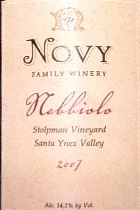
External search
Google (images)
Wine Advocate
Wine Spectator
Burghound
Wine-Searcher
Vintages
2008
2007
From this producer
Show all wines
All tasting notes
|
| Drinking Windows and Values |
| Drinking window: Drink between 2012 and 2016 (based on 1 user opinion) |
| Community Tasting History |
| Novy Family Wines Producer WebsiteNebbioloNebbiolo is a red grape indigenous to the Piedmont region of Italy in the Northwest. The grape can also be found in other parts of the world, though they are not as respected.
Nebbiolo is often considered the "king of red wines," as it is the grape of the famed wines of Barolo DOCG, Barbaresco DOCG, and Roero DOCG. It is known for high tannins and acidity, but with a distinct finesse. When grown on clay, Nebbiolo can be very powerful, tannic, and require long aging periods to reach its full potential. When grown on sand, the grape exhibits a more approachable body with more elegant fruit and less tannins, but still has high aging potential.
"Nebbiolo" is named for the Italian word, "nebbia", which means "fog", in Italian and rightfully so since there is generally a lot of fog in the foothills of Piedmont during harvest.
Nebbiolo is a late-ripening variety that does best in a continental climate that boasts moderate summers and long autumns. In Piedmont, Nebbiolo is normally harvested in October.
More links:
Varietal character (Appellation America) | Nebbiolo on CellarTrackerStolpman Vineyard On weinlagen-infoUSAAmerican wine has been produced since the 1500s, with the first widespread production beginning in New Mexico in 1628. Today, wine production is undertaken in all fifty states, with California producing 84% of all U.S. wine. The continent of North America is home to several native species of grape, including Vitis labrusca, Vitis riparia, Vitis rotundifolia, and Vitis vulpina, but the wine-making industry is based almost entirely on the cultivation of the European Vitis vinifera, which was introduced by European settlers. With more than 1,100,000 acres (4,500 km2) under vine, the United States is the fourth-largest wine producing country in the world, after Italy, Spain, and France.California2021 vintage: "Unlike almost all other areas of the state, the Russian River Valley had higher than normal crops in 2021, which has made for a wine of greater generosity and fruit forwardness than some of its stablemates." - Morgan Twain-Peterson Central Coasthttp://www.ccwinegrowers.org/links.html
http://www.discovercaliforniawines.com/regional-wine-organizations/
http://beveragetradenetwork.com/en/btn-academy/list-of-winegrowers-association-in-central-coast-california-274.htm
Central Coast AVA WikipediaSanta Ynez ValleyThe Santa Ynez Valley AVA is the largest wine sub-region of Santa Barbara County and has the highest concentration of vineyards. The valley runs from east to west, between the Purisima Hills and the San Rafael Mountains in the north, and the Santa Ynez Mountains in the south. Although the valley is open to the Pacific Ocean in the west, the fact that it is relatively narrow means that limited cool air and fog is funnelled in. Low average rainfall and a very long growing season make the region ideal for quality wine production.
The diverse climates of Santa Ynez Valley mean that a wide array of wines is produced. The cool, western part of the AVA is predominantly planted with Pinot Noir and Chardonnay, accompanied by other aromatic white varieties. Botrytis cinerea (noble rot) is able to flourish here, allowing some outstanding dessert wines to be produced in suitable vintages. Further east, the cooling effect of the ocean is lessened as both vineyard elevation and average temperatures increase. This warmer part of Santa Ynez Valley is more suited to fuller-bodied grape varieties, such as Syrah and Merlot.
more ...s expected, Chardonnay and Pinot Noir thrive, while the more inland zones lay claim to Bordeaux varietals and some Rhone blends. |
|


